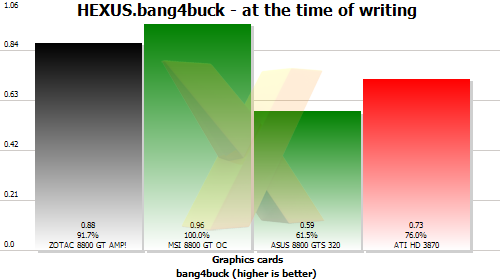HEXUS.bang4buck and overclocking
HEXUS.bang4buck
In a rough-and-ready assessment of the cards' bang per buck, we've aggregated the 1680x1050 frame rates for the three games, normalised them* and taken account of listed the cards' prices.
But there are more provisos than we'd care to shake a stick at. We could have chosen three different games, the cards' prices could have been derived from other sources and pricing tends to fluctuate daily.
Consequently, the table and graph below highlight a metric that should
only be used as a yardstick for evaluating comparative performance with
price factored in. Other architectural benefits are not covered,
obviously.
| Graphics cards | ZOTAC GeForce 8800 GT 512MiB AMP! Edition | MSI NX8800GT-T2D512E-OC 512MiB | ASUS GeForce 8800 GTS 320MiB | ATI Radeon HD 3870 512MiB |
|---|---|---|---|---|
| Actual aggregate marks at 1680x1050 | 227.38 | 218.9 | 149.16 | 155.71 |
| Aggregate marks, normalised*, at 1680x1050 | 175.56 | 168.24 | 105.61 | 110.59 |
| Current price | £199 | £175 | £180 | £150 |
| HEXUS.bang4buck score at 1680x1050 | 0.88 | 0.96 | 0.59 | 0.73 |
| Acceptable frame rate (av. 60fps) at 1680x1050 | No (LP, CoH DX10) | No (QW, LP, CoH DX10) | No (QW, LP, CoH DX10) | No (QW, LP, CoH DX10) |
* The normalisation refers to taking playable frame rate into account. Should a card benchmark at over 60 frames per second in any one game, the extra fps count as half. Similarly, should a card benchmark lower, say at 40fps, we deduct half the difference from its average frame rate and the desired 60fps, giving it a bang4buck score of 30 marks. The minimum allowable frame rate is 20fps but that scores zero.
As an example, should a card score 120fps we treat it as 90fps as only half the frame rate above 60fps is counted for the bang4buck - this is the formula: (120-((120-60)/2)). Similarly, should it score 30fps, we count it as only 15fps: (30+((30-60)/2)).
The reasoning behind such calculation lies with playable frame rates.
Should card A score 110fps in a benchmark and card B 160, then card B would otherwise receive an extra 50 marks in our bang4buck assessment, even though both cards produce perfectly playable frame rates and anything above 60fps is a bonus and not a necessity for most.
Similarly, without our adjustments, the aggregated bang4buck total for two very different cards would be identical if, in a further benchmark, card A scored a smooth 70fps and card B an unplayable 20fps. Both would win marks totally 180, yet the games-playing experience would be vastly different.
A more realistic (and useful) assessment would say that card A is better because it ran smoothly in both games - and that view would be accurately reflected in our adjusted aggregation, where card A would receive 150 marks (85+65) and card B 100 (100+0).
In effect, we're including a desired average frame rate, in this case 60, and penalising lower performance while giving frame rates higher than 60fps only half as much credit as those up to 60fps. If this doesn't make sense or you have issue with it, please hit the HEXUS community.
Here's the HEXUS.bang4buck graph at 1680x1050.

The graph divides the normalised score by the price.
The high-ish £199 asking price for the ZOTAC AMP! Edition is reflected by a HEXUS.bang4buck that is lower than the competing MSI's.
What we can also say is that whilst the Radeon HD 3870 512 is £50 cheaper, its lower price is compromised by exponentially lower normalised performance. In other words, spending more is worth it.
Overclocking
Indicating that ZOTAC is playing the overclocking game without much of a safety net, we were unable to overclock the core/shader speeds above the default 700/1674 without running into stability-related problems. The GDDR3 memory was inched up to an effective 2072MHz, up from the pre-overclocked's 2000MHz. We've not included overclocked numbers due to them falling within the standard deviation of the regular set.700/1674/2000MHz, then, is about as high as one can go with a single-slot-taking cooler.









